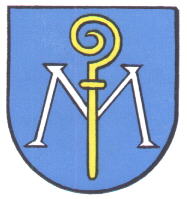Münster (Stuttgart): Difference between revisions
Jump to navigation
Jump to search
Knorrepoes (talk | contribs) m (Text replacement - "/Arms of " to "/Arms (crest) of ") |
Knorrepoes (talk | contribs) m (Text replacement - "{{media}}" to " {{de1}} {{media1}}") |
||
| Line 24: | Line 24: | ||
When the village required a new seal and arms in 1905 the State Archives proposed to add a crosier, and determine the colours as either silver on red or gold on blue. The crosier is a symbol for the [[Lorch Abbey]], to which the village belonged from the 12<sup>th</sup> century onwards. The village decided upon the above colours. | When the village required a new seal and arms in 1905 the State Archives proposed to add a crosier, and determine the colours as either silver on red or gold on blue. The crosier is a symbol for the [[Lorch Abbey]], to which the village belonged from the 12<sup>th</sup> century onwards. The village decided upon the above colours. | ||
{{ | |||
{{de1}} | |||
{{media1}} | |||
[[Civic Heraldry Literature - Germany|'''Literature''']]: Bardua, 1973. | [[Civic Heraldry Literature - Germany|'''Literature''']]: Bardua, 1973. | ||
Revision as of 11:00, 26 December 2022
This page is part of the German heraldry portal Deutsche Wappensammlung |
Heraldry of the World |
|
German heraldry:
|
Selected collector's items from Germany:
|
MÜNSTER
State : Baden-Württemberg
District (Kreis) : Stuttgart
Incorporated into : 1931 Stuttgart
| German | |
| English | (Stuttgart) No blazon/translation known. Please click here to send your (heraldic !) blazon or translation |
Origin/meaning
The oldest seal of Münster dates from 1611 and is thereby one of the oldest village seals in the area. It showed the letter M.
When the village required a new seal and arms in 1905 the State Archives proposed to add a crosier, and determine the colours as either silver on red or gold on blue. The crosier is a symbol for the Lorch Abbey, to which the village belonged from the 12th century onwards. The village decided upon the above colours.
Literature: Bardua, 1973.


